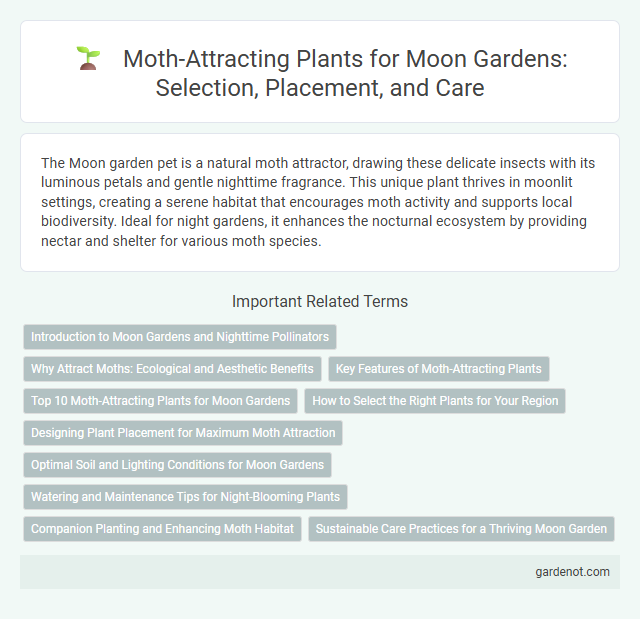The Moon garden pet is a natural moth attractor, drawing these delicate insects with its luminous petals and gentle nighttime fragrance. This unique plant thrives in moonlit settings, creating a serene habitat that encourages moth activity and supports local biodiversity. Ideal for night gardens, it enhances the nocturnal ecosystem by providing nectar and shelter for various moth species.
Introduction to Moon Gardens and Nighttime Pollinators
Moon gardens are designed to illuminate nocturnal beauty through white or pale-colored flowers that glow under moonlight, attracting nighttime pollinators such as moths. Moths serve as primary pollinators in these gardens, drawn by the scent and luminescent petals that provide navigation cues during darkness. Their role enhances biodiversity and supports ecosystems that rely on evening pollination cycles.
Why Attract Moths: Ecological and Aesthetic Benefits
Moth attractors enhance Moon gardens by drawing diverse moth species that play critical roles in pollination and nighttime ecosystem balance. These gardens benefit ecologically as moths support plant reproduction and contribute to biodiversity, while aesthetically they create a dynamic, glowing environment with subtle movement and delicate wing patterns in moonlit settings. Selecting native, fragrant night-blooming plants like Nicotiana and evening primrose maximizes moth visitation and enriches the Moon garden's natural beauty and ecological function.
Key Features of Moth-Attracting Plants
Moth-attracting plants emit strong nocturnal fragrances and display pale or white blossoms that enhance visibility in moonlight, effectively luring moths. Key features include nectar-rich flowers that provide essential nourishment and bloom predominantly during evening hours, supporting nighttime pollinators. These plants often possess a tubular floral structure, facilitating easy access for moth proboscises and promoting efficient pollination.
Top 10 Moth-Attracting Plants for Moon Gardens
Top 10 moth-attracting plants for moon gardens include evening primrose, moonflower, nicotiana, and four o'clock, each known for their strong nocturnal fragrance that lures moths. Other key species such as jasmine, honeysuckle, and night-blooming cereus provide ample nectar and pale, reflective blooms that enhance visibility under moonlight. These plants support nighttime pollinators, creating a vibrant ecosystem and a serene garden atmosphere after dusk.
How to Select the Right Plants for Your Region
Selecting the right plants for a moon garden with moth attractors involves prioritizing native night-blooming species such as evening primrose, four o'clock flowers, and nicotiana, which emit strong fragrances after dusk to lure moths. Consider local climate zones and soil conditions to ensure plant survival and optimal blooming periods during peak moth activity times. Incorporating diverse nectar sources and continuous bloom cycles enhances moth visitation and supports local pollinator populations effectively.
Designing Plant Placement for Maximum Moth Attraction
Strategically positioning night-blooming plants such as Nicotiana, Evening Primrose, and Four O'Clocks maximizes moth attraction by offering abundant nectar sources during peak nocturnal activity. Incorporating highly fragrant flowers near dimly lit areas enhances moth navigation and encourages prolonged visitation. Ensuring a mix of varying flower shapes and bloom times supports diverse moth species throughout the evening and night.
Optimal Soil and Lighting Conditions for Moon Gardens
Moth attractors in moon gardens thrive in well-drained, loamy soil enriched with organic matter to retain moisture without waterlogging. These plants require partial to full moonlight exposure, as their nocturnal blooming is enhanced under soft, silvery light reflecting off the moon's surface. Strategically placing moth attractors in areas with minimal artificial lighting optimizes pollination and visual impact during nighttime garden strolls.
Watering and Maintenance Tips for Night-Blooming Plants
Watering night-blooming plants in a moon garden requires maintaining consistently moist soil without causing waterlogging, typically watering deeply once or twice a week depending on climate and soil type. Applying mulch around moth attractors like evening primrose and nicotiana helps retain moisture and suppress weeds, reducing the need for frequent watering. Regularly removing spent flowers and inspecting for pests ensures healthy growth and maximizes nocturnal blooms that attract moths.
Companion Planting and Enhancing Moth Habitat
Plant night-blooming flowers such as evening primrose and nicotiana near your moon garden to serve as effective moth attractors. Incorporate native grasses and shrubs to provide shelter and breeding sites, enhancing moth habitat diversity. Companion planting with aromatic herbs like lavender or mint can also improve moth visitation by offering nectar and scent cues.
Sustainable Care Practices for a Thriving Moon Garden
Moth attractors in a moon garden thrive through sustainable care practices such as planting native night-blooming flowers that provide nectar and habitat without harmful pesticides. Incorporating organic compost and natural pest control promotes healthy soil and supports nocturnal pollinators, enhancing biodiversity. Regular monitoring and watering using drip irrigation conserve resources while maintaining optimal conditions for moth populations.
Moth attractor Infographic

 gardenot.com
gardenot.com